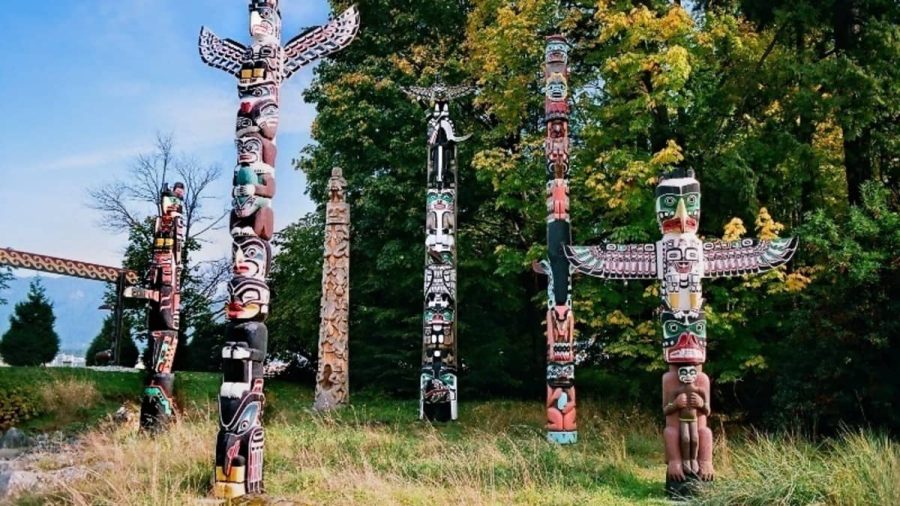The Spiritual Aspects of Native American Art in the Northwest
April 17, 2023
Vibrant renditions of incorporeal creatures, the polyphonic voices of the Spirits, shaped with carved bone and stone; all crafted by illustrious Native artisans. Traditional pieces of art, such as the well-known totems and image of the mighty Thunderbird, could have their meanings dismissed past visual flair. In the grander culture of Northwest Native tribes, however, their representations contribute to substantially more. The art of these Native American tribes was primarily created for its spiritual and ceremonial value, which varied based on the materials the terrain provided and mediums appropriate for the messages being conveyed, as well as who could do so. This is seen in the compositions preserved until today, their remnants indicative of something otherworldly.
Northwest Native American tribal art was created mainly for its ethereal and ancestral significance. The famous totem poles of the Pacific Northwest, in particular, portray these motives. With figures carved into them, as seen below, these looming constructions generally represented “ancestors and supernatural beings” as “crests, symbols of their identity” (washington.edu 1). In order to preserve their clan’s legacy, Native tribes of the Pacific Northwest would form and then set up these physical installations. There are certainly literal meanings attached to these, especially with the use of animals local to the region, and faces of family and foreigners alike. Looking at these pieces from a metaphysical perspective yields a greater understanding of their initial intentions, such as an explanation for bears being a symbol of the tribes’ powerful ancestors, or the uniformed, armed White men signifying the darkness of America’s colonial era towards indigenous groups. These images were bound not only by their intellectual capabilities, but also what supplies the Earth provided them.

Haida Chief Skolka’s Totem
— “Watchmen” with hats at top, served house owners by warning of potential danger.
— Carvings of European men with military uniforms, speculation still occurs regarding their meaning.
— The Owl at the top is part of Skolka’s clan.
Washington.edu
The final results of the pieces varied depending on what the local land provided. Colonization allowed for more than just the introduction of diseases and Christocentric schemes; in this case, it made for new art supplies. In North America, the Pacific Northwest is distinctive with its lush green forests and dynamic blue coastlines. Native American artists used these as inspiration, with rich blues being introduced by “woolen material carried by travelers” along with the local greens “derived from copper minerals… native moss” (Suing 5). Originally, the artisans of the Pacific Northwest Native American tribes were limited to the earthy tones of the region, leading to more muted arrays until the (colonial) introduction of vibrant colors. The most critical of these were the blue materials, expanding depictions of the nearby ocean and sky. This expansion significantly improved the accuracy of the depictions of the Thunderbird, an almighty being that roams the forests and warns of forthcoming storms. The Thunderbird is said to traditionally have black and blue tones, but was portrayed as red and black due to previous limitations. Apart from the choice of materials and colors available, there was the question of how to represent the age-old spirits.
Double-Thunderbird
— Here, blue is the primary color.
Wikimedia.org
Northwest Native American art also differed based on which mediums were appropriate for the messages being communicated, along with who portrayed them best. Totem poles, while arguably the most popular forms of art in the Pacific Northwest, were not always best suited for the records passed down, leaving shamans to resort to other means. They were especially powerful individuals who “have the ability to… communicate with spirit guides”, “[employing] drums” to do so (Suing 2). These few were the most powerful members of their respective tribes, and ensured their legacy through music. In some cases, leaving the, although extremely detailed, totem poles up was not enough to convey the intricacy of a lesson or tale. That is why the shamans resorted to performance art, channeling the numerous voices of spirits through their vocal cords, profound emotion spilling out of booming percussion. The songs and instruments to execute these productions would be passed down among generations, presenting auditory and physical records.
The artistic contributions of Northwest Native American tribes are recognized for their spiritual undertones and ceremonial traditions. These compositions were not only limited to the creative reach of the artisans, but reflected the earthly bounds of the region. If not concerned with the materials available, it was the responsibility of the powerful few from these groups to designate how they would present certain messages. The tools signature to each medium are somewhat present today, although in few locations. While it is easy to call Native American art “cool” and not look for much past its conspicuous creatures, it is important to acknowledge the symbols utilized and how they were portrayed, especially when there are so few remnants of craftsmanship left today after North America’s vast colonization.
Works Cited
“American Indians Of The Pacific Northwest Collection”. Content.Lib.Washington.Edu, 2021, https://content.lib.washington.edu/aipnw/wright.html.
“Haida Double Thunderbird 1880.Jpg – Wikimedia Commons”. Commons.Wikimedia.Org, 1888, https://commons.wikimedia.org/wiki/File:Haida_double_thunderbird_1880.jpg.
“Haida Skolka’s Totem Pole, Howkan Village, Long Island, Alaska, Ca. 1923.”. Digitalcollections.Lib.Washington.Edu, 2021, https://digitalcollections.lib.washington.edu/digital/collection/loc/id/1906/.
Metmuseum.Org, 2021, https://www.metmuseum.org/toah/hd/nort/hd_nort.htm. Suing, Michael.


